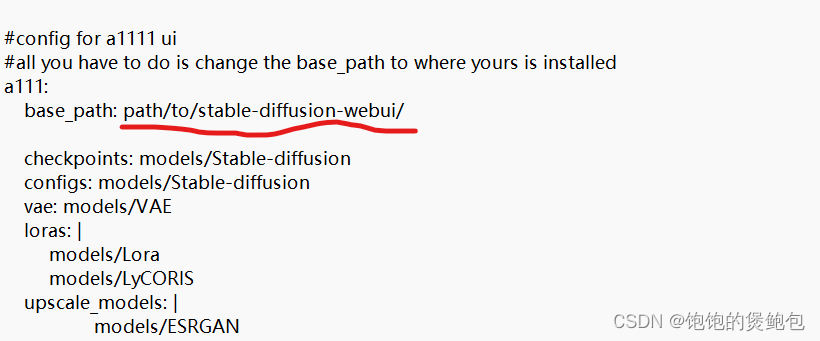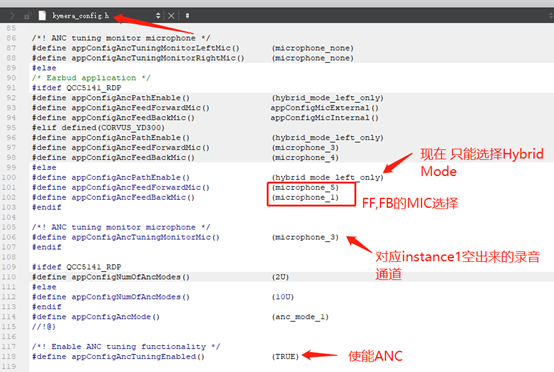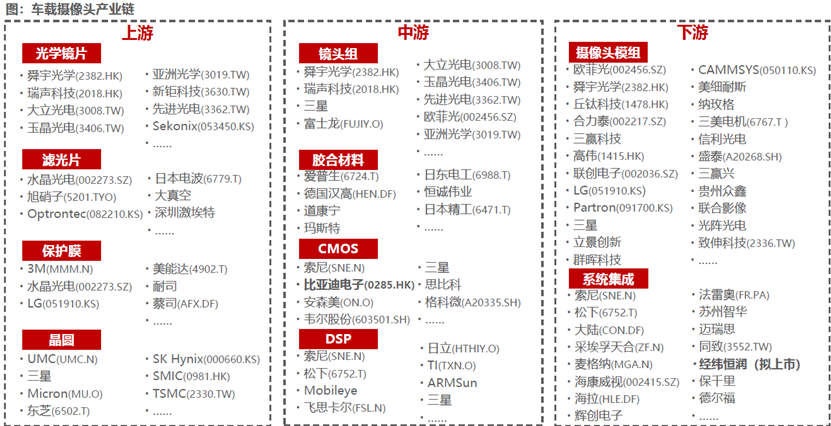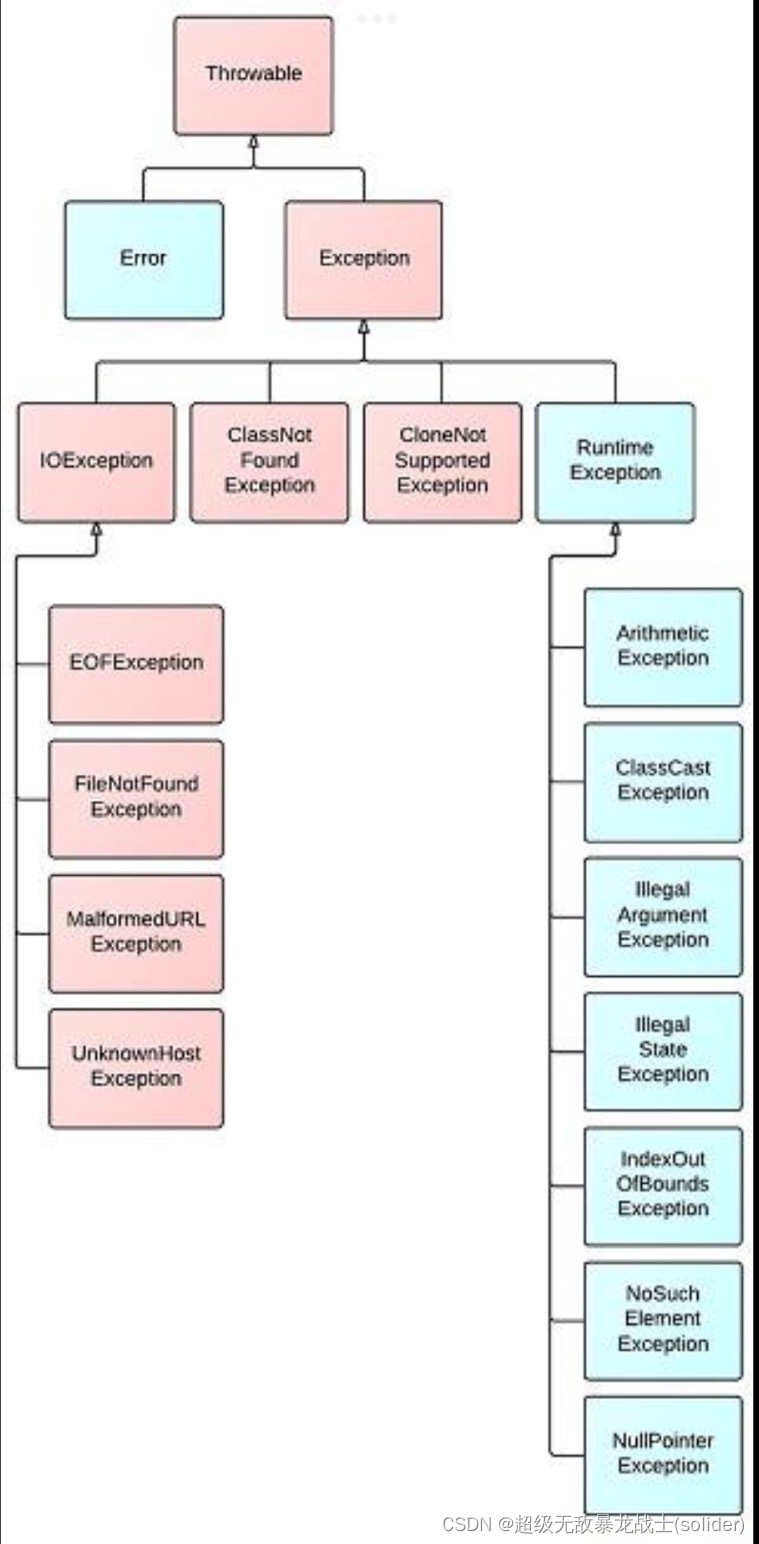C++哈希
- 1.unordered_mapd
- 1.1unordered_map的构造函数
- 1.2unorder_map的容量
- 1.3unordered_map的迭代器
- 1.4unordered_map的元素访问
- 1.5unorder_map的查找
- 1.6unordered_map的修改操作
- 1.7unordered_map的桶操作
- 2.unordered_set
- 3.unordered_set和unordered_set的笔试题
- 4.哈希
- 4.1哈希概念
- 4.2哈希冲突
- 4.3哈希函数
- 4.4哈希冲突解决
- 4.4.1闭散列
- 4.4.1.1线性探测的实现
- 4.4.2开散列
- 4.4.2.1开散列的实现
- 4.unordered_map和unordered_set模拟实现
- 4.1哈希表的改造
- 4.2unordered_set模拟实现
- 4.3unordered_map模拟实现
- 5.位图
- 5.1位图的实现
- 5.2布隆过滤器
- 5.2.1布隆过滤器的实现
1.unordered_mapd
C++unorder_map官方文档
1.1unordered_map的构造函数
| 函数声明 | 功能介绍 |
|---|---|
| unordered_map | 构造不同格式的unordered_map对象 |
1.2unorder_map的容量
| 函数声明 | 功能介绍 |
|---|---|
| bool empty() const | 检测unordered_map是否为空 |
| size_t size() const | 获取unordered_map的有效元素个数 |
1.3unordered_map的迭代器
| 函数声明 | 功能介绍 |
|---|---|
| begin | 返回unordered_map第一个元素的迭代器 |
| end | 返回unordered_map最后一个元素下一个位置的迭代器 |
| cbegin | 返回unordered_map第一个元素的const迭代器 |
| cend | 返回unordered_map最后一个元素下一个位置的const迭代器 |
1.4unordered_map的元素访问
| 函数声明 | 功能介绍 |
|---|---|
| operator[] | 返回与key对应的value,没有则返回一个默认值 |
注意:
该函数中实际调用哈希桶的插入操作,用参数key与V()构造一个默认值往底层哈希桶中插入,如果key不在哈希桶中,插入成功,返回V(),插入失败,说明key已经在哈希桶中,将key对应的value返回。
1.5unorder_map的查找
| 函数声明 | 功能介绍 |
|---|---|
| iterator find(const K& key) | 返回key在哈希桶中的位置 |
| size_t count(const K& key) | 返回哈希桶中关键码为key的键值对的个数 |
注意:unordered_map中key是不能重复的,因此count函数的返回值最大为1
1.6unordered_map的修改操作
| 函数声明 | 功能介绍 |
|---|---|
| insert | 向容器中插入键值对 |
| erase | 删除容器中的键值对 |
| void clear() | 清空容器中有效元素个数 |
| void swap(unorder map&) | 交换两个容器中的元素 |
1.7unordered_map的桶操作
| 函数声明 | 功能介绍 |
|---|---|
| size_t bucket count()const | 返回哈希桶中桶的总个数 |
| size_t bucket size(size_t n)const | 返回n号桶中有效元素的总个数 |
| size_t bucket(const K& key) | 返回元素key所在的桶号 |
2.unordered_set
C++unordered_set官方文档
这里不在一 一列举
3.unordered_set和unordered_set的笔试题
在长度 2N 的数组中找出重复 N 次的元素
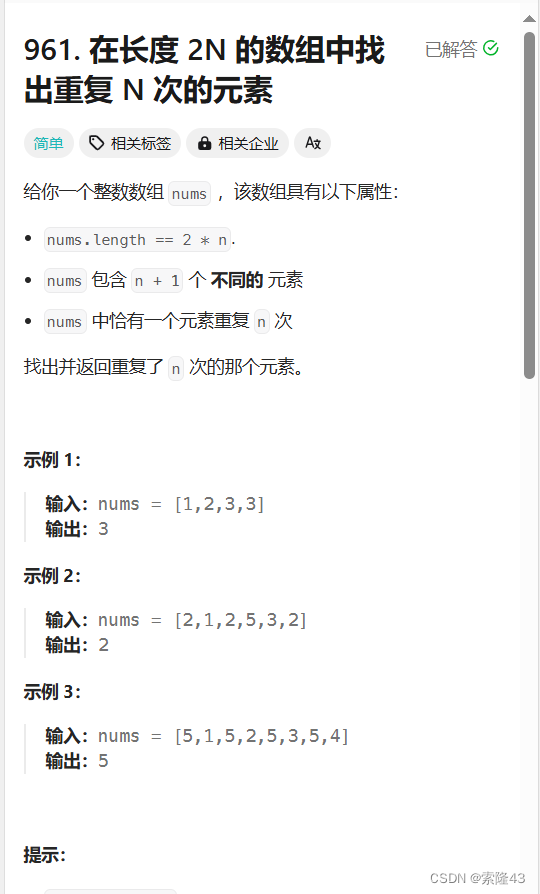
class Solution {
public:
int repeatedNTimes(vector<int>& nums)
{
unordered_map<int, int> found;
for (int num : nums)
{
found[num]++;
}
for (auto it = found.begin(); it != found.end(); ++it)
{
if (it->second == nums.size() / 2)
{
return it->first;
}
}
return -1;
}
};
两个数组的交集
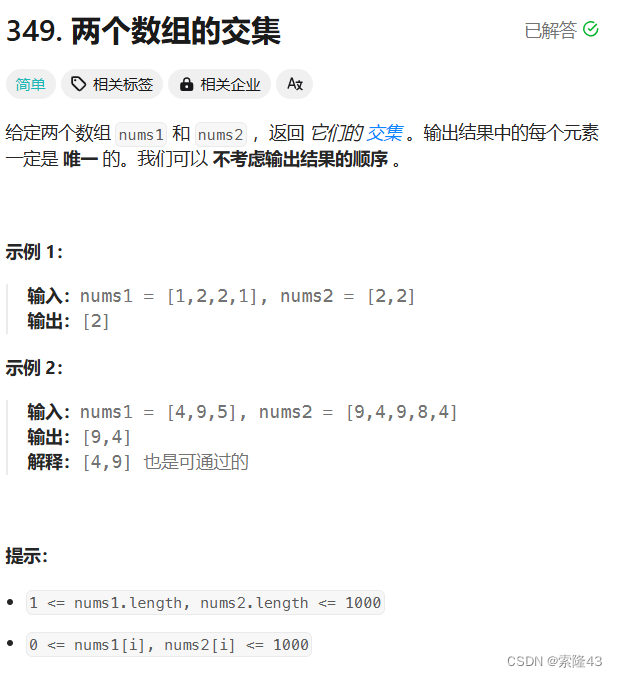
class Solution {
public:
vector<int> intersection(vector<int>& nums1, vector<int>& nums2)
{
set<int> s1(nums1.begin(),nums1.end());
set<int> s2(nums2.begin(),nums2.end());
auto it1=s1.begin();
auto it2=s2.begin();
vector<int> v;
while(it1!=s1.end()&&it2!=s2.end())
{
if(*it1<*it2)
{
++it1;
}
else if(*it1>*it2)
{
++it2;
}
else
{
v.push_back(*it1);
++it1;
++it2;
}
}
return v;
}
};
两个数组的交集 II

class Solution {
public:
vector<int> intersect(vector<int>& nums1, vector<int>& nums2)
{
multiset<int> s1(nums1.begin(),nums1.end());
multiset<int> s2(nums2.begin(),nums2.end());
auto it1=s1.begin();
auto it2=s2.begin();
vector<int> v;
while(it1!=s1.end()&&it2!=s2.end())
{
if(*it1<*it2)
{
it1++;
}
else if(*it1>*it2)
{
it2++;
}
else
{
v.push_back(*it1);
it1++;
it2++;
}
}
return v;
}
};
存在重复元素

class Solution {
public:
bool containsDuplicate(vector<int>& nums)
{
unordered_map<int,int> mp;
for(int num:nums)
{
mp[num]++;
}
auto it=mp.begin();
while(it!=mp.end())
{
if(it->second>=2)
{
return true;
}
++it;
}
return false;
}
};
两句话中的不常见单词
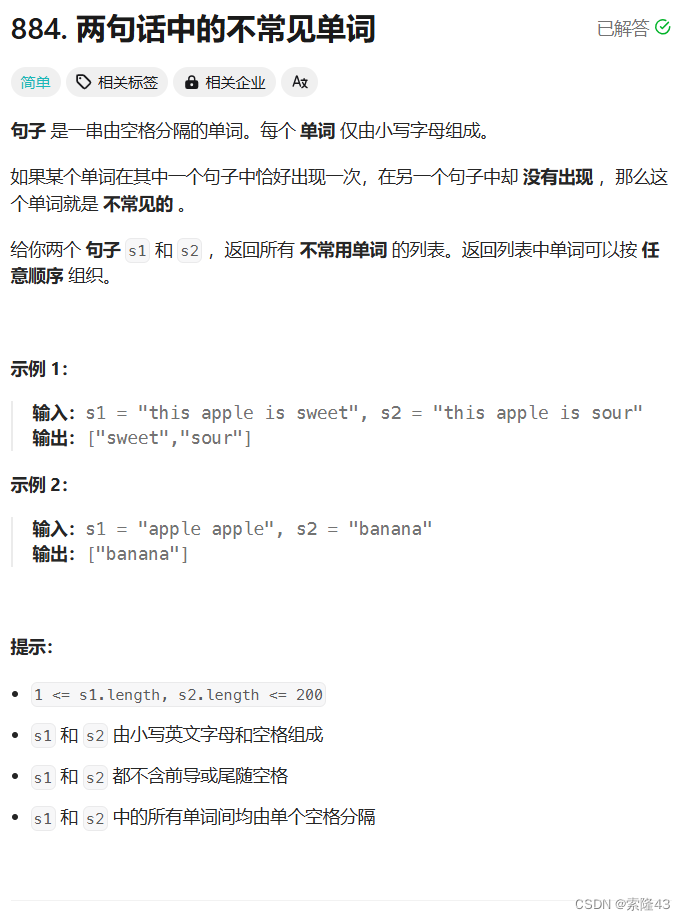
class Solution {
public:
vector<string> uncommonFromSentences(string s1, string s2)
{
vector<string> v;
unordered_map<string,int> mp;
stringstream ss1(s1);
string word;
while(ss1>>word)
{
mp[word]++;
}
stringstream ss2(s2);
while(ss2>>word)
{
mp[word]++;
}
for(auto& w:mp)
{
if(w.second==1)
{
v.push_back(w.first);
}
}
return v;
}
};
4.哈希
4.1哈希概念
通过某种函数(hashFunc)使元素的存储位置与它的关键码之间能够建立一 一映射的关系,在查找时通过该函数可以很快找到该元素。
1.插入元素
根据待插入元素的关键码,以此函数计算出该元素的存储位置并按此位置进行存放
2.搜索元素
对元素的关键码进行同样的计算,把求得的函数值当做元素的存储位置,在结构中按此位置取元素比较,若关键码相等,则找到了
哈希方法中使用的转换函数称为哈希(散列)函数,构造出来的结构称为哈希表(Hash Table)(或者称散列表)
4.2哈希冲突
不同关键字通过相同哈希哈数计算出相同的哈希地址,该种现象称为哈希冲突或哈希碰撞。
4.3哈希函数
哈希函数设计原则:
-
1.哈希函数的定义域必须包括需要存储的全部关键码,而如果散列表允许有m个地址时,其值域必须在0到m-1之间
-
哈希函数计算出来的地址能均匀分布在整个空间中
-
哈希函数应该比较简单
常见的哈希函数 -
直接定址法–(常用)
取关键字的某个线性函数为散列地址:Hash(Key)= A*Key + B
优点:简单、均匀
缺点:需要事先知道关键字的分布情况
使用场景:适合查找比较小且连续的情况 -
除留余数法–(常用)
设散列表中允许的地址数为m,取一个不大于m,但最接近或者等于m的质数p作为除数,
按照哈希函数:Hash(key) = key% p(p<=m),将关键码转换成哈希地址
4.4哈希冲突解决
解决哈希冲突两种常见的方法是:闭散列和开散列
4.4.1闭散列
也叫开放定址法,当发生哈希冲突时,如果哈希表未被装满,说明在哈希表中必然还有空位置,那么可以把key存放到冲突位置中的“下一个” 空位置中去。
线性探测:从发生冲突的位置开始,依次向后探测,直到寻找到下一个空位置为止。
1.插入
- 通过哈希函数获取待插入元素在哈希表中的位置
- 如果该位置中没有元素则直接插入新元素,如果该位置中有元素发生哈希冲突, 使用线性探测找到下一个空位置,插入新元素

2.删除
采用闭散列处理哈希冲突时,不能物理删除哈希表中已有的元素,若直接删除元素会影响其他元素的搜索。比如删除元素4,如果直接删除掉,44查找起来可能会受影响。因此线性探测采用标记的伪删除法来删除一个元素。(也就是给位置标记状态)
// 哈希表每个空间给个标记
// EMPTY此位置空, EXIST此位置已经有元素, DELETE元素已经删除
enum State{EMPTY, EXIST, DELETE};
4.4.1.1线性探测的实现
enum Status
{
EMPTY,
EXIST,
DELETE
};
template<class K,class V>
struct HashData
{
pair<K, V> _kv;
Status _s; //状态
};
//HashFunc<int>
template<class K>
struct HashFunc
{
size_t operator()(const K& Key)
{
return (size_t)Key;
}
};
//HashFunc<string>
template<>
struct HashFunc<string>
{
size_t operator()(const string& key)
{
size_t hash = 0;
for (auto e : key)
{
hash *= 31;
hash += e;
}
cout << key << ":" << hash << endl;
return hash;
}
};
template<class K,class V,class Hash=HashFunc<K>>
class HashTable
{
public:
HashTable()
{
_tables.resize(10);
}
bool Insert(const pair<K, V>& kv)
{
if (Find(kv.first))
{
return false;
}
//负载因子0.7就扩容
if (_n * 10 / _tables.size() == 7)
{
size_t newSize = _tables.size() * 2;
HashTable<K, V> newHT;
newHT._tables.resize(newSize);
for (size_t i = 0;i < _tables.size();i++)
{
if (_tables[i]._s == EXIST)
{
newHT.Insert(_tables[i]._kv);
}
}
_tables.swap(newHT._tables);
}
Hash hf;
size_t hashi = hf(kv.first) % _tables.size();
while (_tables[hashi]._s == EXIST)
{
hashi++;
hashi %= _tables.size();
}
_tables[hashi]._kv = kv;
_tables[hashi]._s = EXIST;
++_n;
return true;
}
HashData<K, V>* Find(const K& key)
{
Hash hf;
size_t hashi = hf(key) % _tables.size();
while (_tables[hashi]._s != EMPTY)
{
if (_tables[hashi]._s == EXIST && _tables[hashi]._kv.first == key)
{
return &_tables[hashi];
}
hashi++;
hashi %= _tables.size();
}
return nullptr;
}
bool Erase(const K& key)
{
HashData<K, V>* ret = Find(key);
if (ret)
{
ret->_s = DELETE;
--_n;
return true;
}
else
{
return false;
}
}
void Print()
{
for (size_t i = 0;i < _tables.size();i++)
{
if (_tables[i]._s == EXIST)
{
cout << "[" << i << "]->" << _tables[i]._kv.first << ":" << _tables[i]._kv.second << endl;
}
else if (_tables[i]._s == EMPTY)
{
printf("[%d]->\n", i);
}
else
{
printf("[%d]->D\n", i);
}
}
cout << endl;
}
private:
vector<HashData<K,V>> _tables;
size_t _n = 0;//存储的关键字的个数
};
线性探测优点:实现非常简单
线性探测缺点:一旦发生哈希冲突,所有的冲突连在一起,容易产生数据“堆积”,即:不同
关键码占据了可利用的空位置,使得寻找某关键码的位置需要许多次比较,导致搜索效率降
低。
4.4.2开散列
开散列法又叫链地址法(开链法),首先对关键码集合用散列函数计算散列地址,具有相同地
址的关键码归于同一子集合,每一个子集合称为一个桶,各个桶中的元素通过一个单链表链
接起来,各链表的头结点存储在哈希表中。

4.4.2.1开散列的实现
//HashFunc<int>
template<class K>
struct HashFunc
{
size_t operator()(const K& Key)
{
return (size_t)Key;
}
};
//HashFunc<string>
template<>
struct HashFunc<string>
{
size_t operator()(const string& key)
{
size_t hash = 0;
for (auto e : key)
{
hash *= 31;
hash += e;
}
cout << key << ":" << hash << endl;
return hash;
}
};
template<class K, class V>
struct HashNode
{
HashNode* _next;
pair<K, V> _kv;
HashNode(const pair<K, V>& kv)
:_kv(kv)
, _next(nullptr)
{}
};
template<class K, class V,class Hash=HashFunc<K>>
class HashTable
{
typedef HashNode<K, V> Node;
public:
HashTable()
{
_tables.resize(10);
}
~HashTable()
{
for (size_t i = 0; i < _tables.size(); i++)
{
Node* cur = _tables[i];
while (cur)
{
Node* next = cur->_next;
delete cur;
cur = next;
}
_tables[i] = nullptr;
}
}
bool Insert(const pair<K, V>& kv)
{
if (Find(kv.first))
return false;
Hash hf;
// 负载因子最大到1
if (_n == _tables.size())
{
vector<Node*> newTables;
newTables.resize(_tables.size() * 2, nullptr);
// 遍历旧表
for (size_t i = 0; i < _tables.size(); i++)
{
Node* cur = _tables[i];
while (cur)
{
Node* next = cur->_next;
//挪动到映射的新表
size_t hashi = hf(cur->_kv.first) % newTables.size();
cur->_next = newTables[hashi];//标记
newTables[hashi] = cur;
cur = next;
}
_tables[i] = nullptr;
}
_tables.swap(newTables);
}
size_t hashi = hf(kv.first) % _tables.size();
Node* newnode = new Node(kv);
// 头插
newnode->_next = _tables[hashi];
_tables[hashi] = newnode;
++_n;
return true;
}
Node* Find(const K& key)
{
Hash hf;
size_t hashi = hf(key) % _tables.size();
Node* cur = _tables[hashi];
while (cur)
{
if (cur->_kv.first == key)
{
return cur;
}
cur = cur->_next;
}
return nullptr;
}
bool Erase(const K& key)
{
Hash hf;
size_t hashi = hf(key) % _tables.size();
Node* prev = nullptr;
Node* cur = _tables[hashi];
while (cur)
{
if (cur->_kv.first == key)
{
if (prev == nullptr)
{
_tables[hashi] = cur->_next;
}
else
{
prev->_next = cur->_next;
}
delete cur;
return true;
}
prev = cur;
cur = cur->_next;
}
return false;
}
void Some()
{
size_t bucketSize = 0;
size_t maxBucketLen = 0;
size_t sum = 0;
double averageBucketLen = 0;
for (size_t i = 0;i < _tables.size();i++)
{
Node* cur = _tables[i];
if (cur)
{
++bucketSize;
}
size_t bucketLen = 0;
while (cur)
{
++bucketLen;
cur = cur->_next;
}
sum += bucketLen;
if (bucketLen > maxBucketLen)
{
maxBucketLen = bucketLen;
}
}
printf("all bucketSize:%d\n", _tables.size());
printf("bucketSize:%d\n", bucketSize);
printf("maxBucketLen:%d\n", maxBucketLen);
printf("averageBucketLen:%lf\n\n", averageBucketLen);
}
private:
vector<Node*> _tables;
size_t _n = 0;
};
4.unordered_map和unordered_set模拟实现
4.1哈希表的改造
//HashFunc<int>
template<class K>
struct HashFunc
{
size_t operator()(const K& Key)
{
return (size_t)Key;
}
};
//HashFunc<string>
template<>
struct HashFunc<string>
{
size_t operator()(const string& key)
{
size_t hash = 0;
for (auto e : key)
{
hash *= 31;
hash += e;
}
cout << key << ":" << hash << endl;
return hash;
}
};
namespace hash_bucket
{
template<class T>
struct HashNode
{
HashNode* _next;
T _data;
HashNode(const T& data)
:_data(data)
, _next(nullptr)
{}
};
// 前置声明
template<class K, class T, class KeyOfT, class Hash>
class HashTable;
template<class K,class T,class Ref,class Ptr,class KeyOfT,class Hash>
struct __HTIterator
{
typedef HashNode<T> Node;
typedef __HTIterator<K, T, Ref, Ptr, KeyOfT, Hash> Self;
Node* _node;
const HashTable<K, T, KeyOfT, Hash>* _pht;
size_t _hashi;
__HTIterator(Node* node,HashTable<K,T,KeyOfT,Hash>* pht,size_t hashi)
:_node(node)
,_pht(pht)
,_hashi(hashi)
{}
__HTIterator(Node* node, const HashTable<K, T, KeyOfT, Hash>* pht, size_t hashi)
:_node(node)
, _pht(pht)
, _hashi(hashi)
{}
Self& operator++()
{
if (_node->_next)
{
_node = _node->_next;
}
else
{
++_hashi;
while (_hashi < _pht->_tables.size())
{
if (_pht->_tables[_hashi])
{
_node = _pht->_tables[_hashi];
break;
}
++_hashi;
}
if (_hashi == _pht->_tables.size())
{
_node = nullptr;
}
}
return *this;
}
Ref operator*()
{
return _node->_data;
}
Ptr operator->()
{
return &(_node->_data);
}
bool operator!=(const Self& s)
{
return _node != s._node;
}
};
//unordered_set->HashTable<K,K>
//unordered_map->HashTable<K,pair<K,V>>
template<class K, class T,class KeyOfT,class Hash>
class HashTable
{
typedef HashNode<T> Node;
template<class K, class T, class Ref, class Ptr, class KeyOfT, class Hash>
friend struct __HTIterator;
public:
typedef __HTIterator<K, T, T&, T*, KeyOfT, Hash> iterator;
typedef __HTIterator<K, T, const T&, const T*, KeyOfT, Hash> const_iterator;
iterator begin()
{
for (size_t i = 0;i < _tables.size();i++)
{
if (_tables[i])
{
return iterator(_tables[i], this, i);
}
}
return end();
}
iterator end()
{
return iterator(nullptr, this, -1);
}
const_iterator begin() const
{
for (size_t i = 0;i < _tables.size();i++)
{
if (_tables[i])
{
return const_iterator(_tables[i], this, i);
}
}
return end();
}
const_iterator end() const
{
return const_iterator(nullptr, this, -1);
}
HashTable()
{
_tables.resize(10);
}
~HashTable()
{
for (size_t i = 0; i < _tables.size(); i++)
{
Node* cur = _tables[i];
while (cur)
{
Node* next = cur->_next;
delete cur;
cur = next;
}
_tables[i] = nullptr;
}
}
pair<iterator,bool> Insert(const T& data)
{
Hash hf;
KeyOfT kot;
iterator it = Find(kot(data));
if (it != end())
{
return make_pair(it, false);
}
// 负载因子最大到1
if (_n == _tables.size())
{
vector<Node*> newTables;
newTables.resize(_tables.size() * 2, nullptr);
// 遍历旧表
for (size_t i = 0; i < _tables.size(); i++)
{
Node* cur = _tables[i];
while (cur)
{
Node* next = cur->_next;
//挪动到映射的新表
size_t hashi = hf(kot(data)) % newTables.size();
cur->_next = newTables[hashi];//标记
newTables[hashi] = cur;
cur = next;
}
_tables[i] = nullptr;
}
_tables.swap(newTables);
}
size_t hashi = hf(kot(data)) % _tables.size();
Node* newnode = new Node(data);
// 头插
newnode->_next = _tables[hashi];
_tables[hashi] = newnode;
++_n;
return make_pair(iterator(newnode,this,hashi),true);
}
iterator Find(const K& key)
{
Hash hf;
KeyOfT kot;
size_t hashi = hf(key) % _tables.size();
Node* cur = _tables[hashi];
while (cur)
{
if (kot(cur->_data) == key)
{
return iterator(cur,this,hashi);
}
cur = cur->_next;
}
return end();
}
bool Erase(const K& key)
{
Hash hf;
KeyOfT kot;
size_t hashi = hf(key) % _tables.size();
Node* prev = nullptr;
Node* cur = _tables[hashi];
while (cur)
{
if (kot(cur->_data) == key)
{
if (prev == nullptr)
{
_tables[hashi] = cur->_next;
}
else
{
prev->_next = cur->_next;
}
delete cur;
return true;
}
prev = cur;
cur = cur->_next;
}
return false;
}
void Some()
{
size_t bucketSize = 0;
size_t maxBucketLen = 0;
size_t sum = 0;
double averageBucketLen = 0;
for (size_t i = 0;i < _tables.size();i++)
{
Node* cur = _tables[i];
if (cur)
{
++bucketSize;
}
size_t bucketLen = 0;
while (cur)
{
++bucketLen;
cur = cur->_next;
}
sum += bucketLen;
if (bucketLen > maxBucketLen)
{
maxBucketLen = bucketLen;
}
}
averageBucketLen = (double)sum / (double)bucketSize;
printf("all bucketSize:%d\n", _tables.size());
printf("bucketSize:%d\n", bucketSize);
printf("maxBucketLen:%d\n", maxBucketLen);
printf("averageBucketLen:%lf\n\n", averageBucketLen);
}
private:
vector<Node*> _tables;
size_t _n = 0;
};
}
4.2unordered_set模拟实现
#pragma once
#include"HashTable.h"
namespace ljh
{
template<class K, class Hash = HashFunc<K>>
class unordered_set
{
struct SetKeyOfT
{
const K& operator()(const K& key)
{
return key;
}
};
public:
typedef typename hash_bucket::HashTable<K, K, SetKeyOfT, Hash>::const_iterator iterator;
typedef typename hash_bucket::HashTable<K, K, SetKeyOfT, Hash>::const_iterator const_iterator;
/*iterator begin()
{
return _ht.begin();
}
iterator end()
{
return _ht.end();
}*/
const_iterator begin() const
{
return _ht.begin();
}
const_iterator end() const
{
return _ht.end();
}
pair<const_iterator, bool> insert(const K& key)
{
auto ret = _ht.Insert(key);
return pair<const_iterator, bool>(const_iterator(ret.first._node, ret.first._pht, ret.first._hashi), ret.second);
}
iterator find(const K& key)
{
return _ht.Find(key);
}
bool erase(const K& key)
{
return _ht.Erase(key);
}
private:
hash_bucket::HashTable<K, K, SetKeyOfT, Hash> _ht;
};
}
4.3unordered_map模拟实现
#pragma once
#include"HashTable.h"
namespace ljh
{
template<class K,class V,class Hash=HashFunc<K>>
class unordered_map
{
struct MapKeyOfT
{
const K& operator()(const pair<K, V>& kv)
{
return kv.first;
}
};
public:
typedef typename hash_bucket::HashTable<K, pair<const K, V>, MapKeyOfT, Hash>::iterator iterator;
iterator begin()
{
return _ht.begin();
}
iterator end()
{
return _ht.end();
}
pair<iterator, bool> insert(const pair<K, V>& kv)
{
return _ht.Insert(kv);
}
V& operator[](const K& key)
{
pair<iterator, bool> ret = _ht.Insert(make_pair(key, V()));
return ret.first->second;
}
const V& operator[](const K& key) const
{
pair<iterator, bool> ret = _ht.Insert(make_pair(key, V()));
return ret.first->second;
}
iterator find(const K& key)
{
return _ht.Find(key);
}
bool erase(const K& key)
{
return _ht.Erase(key);
}
private:
hash_bucket::HashTable<K, pair<const K, V>, MapKeyOfT, Hash> _ht;
};
}
5.位图
给40亿个不重复的无符号整数,没排过序。给一个无符号整数,如何快速判断一个数是否在这40亿个数中。
解决方案:
1:暴力遍历:时间复杂度O(N)
2.快排(O(NlogN))+二分查找(logN)
3.位图
数据是否在给定的整形数据中,结果是在或者不在,刚好是两种状态,可以使用一个二进制比特位来代表数据是否存在,如果二进制比特位为1,代表存在,为0代表不存在。
5.1位图的实现
//N为需要多少比特位
template<size_t N>
class bitset
{
public:
bitset()
{
_bits.resize(N / 32 + 1);
}
void set(size_t x)
{
size_t i = x / 32;
size_t j = x % 32;
_bits[i] |= (1 << j);
}
void reset(size_t x)
{
size_t i = x / 32;
size_t j = x % 32;
_bits[i] &= ~(1 << j);
}
bool test(size_t x)
{
size_t i = x / 32;
size_t j = x % 32;
return _bits[i] & (1 << j);
}
private:
vector<int> _bits;
};
template<size_t N>
class twobitset
{
public:
void set(size_t x)
{
//00->01
//01->10
//10->11
//11->不变
if (_bs1.test(x) == false && _bs2.test(x) == false)
{
_bs2.set(x);
}
else if (_bs1.test(x) == false && _bs2.test(x) == true)
{
_bs1.set(x);
_bs2.reset(x);
}
else if (_bs1.test(x) == true && _bs2.test(x) == false)
{
_bs2.set(x);
}
}
void Print()
{
for (size_t i = 0;i < N;i++)
{
if (_bs1.test(i) == false && _bs2.test(i) == true)
{
cout << "1->" << i << endl;
}
else if (_bs1.test(i) == true && _bs2.test(i) == false)
{
cout << "2->" << i << endl;
}
}
cout << endl;
}
private:
bitset<N> _bs1;
bitset<N> _bs2;
};
5.2布隆过滤器
具体实现思想:用多个哈希函数,将一个数据映射到位图结构中
作用:某样东西一定不存在或者可能存在

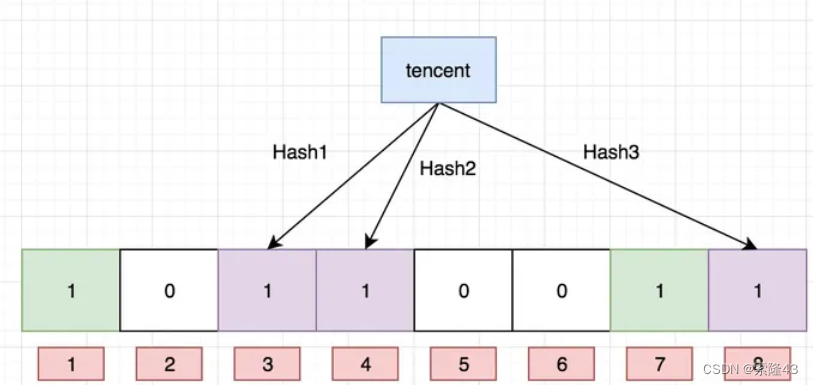
5.2.1布隆过滤器的实现
#include<string>
#include<iostream>
#include<vector>
using namespace std;
#include"bitset.h"
struct BKDRHash
{
size_t operator()(const string& key)
{
// BKDR
size_t hash = 0;
for (auto e : key)
{
hash *= 31;
hash += e;
}
return hash;
}
};
struct APHash
{
size_t operator()(const string& key)
{
size_t hash = 0;
for (size_t i = 0; i < key.size(); i++)
{
char ch = key[i];
if ((i & 1) == 0)
{
hash ^= ((hash << 7) ^ ch ^ (hash >> 3));
}
else
{
hash ^= (~((hash << 11) ^ ch ^ (hash >> 5)));
}
}
return hash;
}
};
struct DJBHash
{
size_t operator()(const string& key)
{
size_t hash = 5381;
for (auto ch : key)
{
hash += (hash << 5) + ch;
}
return hash;
}
};
template<size_t N,class K = string,class HashFunc1 = BKDRHash,class HashFunc2 = APHash,class HashFunc3 = DJBHash>
class BloomFilter
{
public:
void Set(const K& key)
{
size_t hash1 = HashFunc1()(key) % N;
size_t hash2 = HashFunc2()(key) % N;
size_t hash3 = HashFunc3()(key) % N;
_bs.set(hash1);
_bs.set(hash2);
_bs.set(hash3);
}
//void Reset(const K& key);一般不支持删除
bool Test(const K& key)
{
//判断不存在是准确的,其他的都是存在偏差的
size_t hash1 = HashFunc1()(key) % N;
if (_bs.test(hash1) == false)
{
return false;
}
size_t hash2 = HashFunc2()(key) % N;
if (_bs.test(hash2) == false)
{
return false;
}
size_t hash3 = HashFunc3()(key) % N;
if (_bs.test(hash3) == false)
{
return false;
}
// 存在误判的
return true;
}
private:
ljh::bitset<N> _bs;
};

